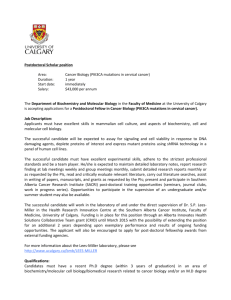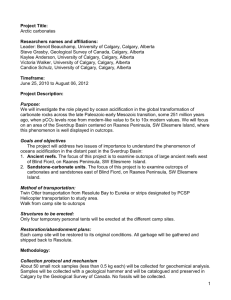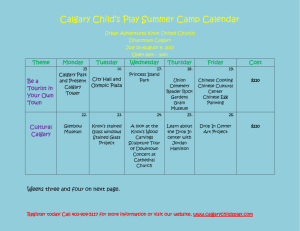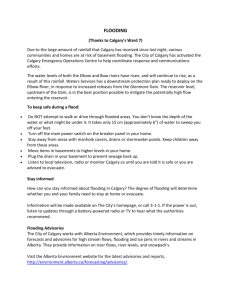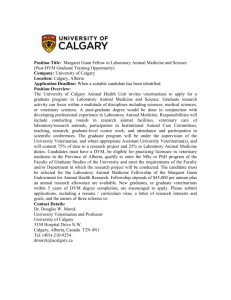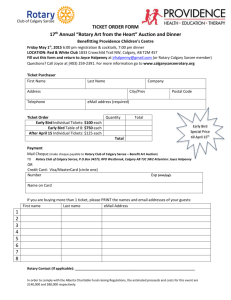MUNICIPAL EXCELLENCE NETWORK
advertisement
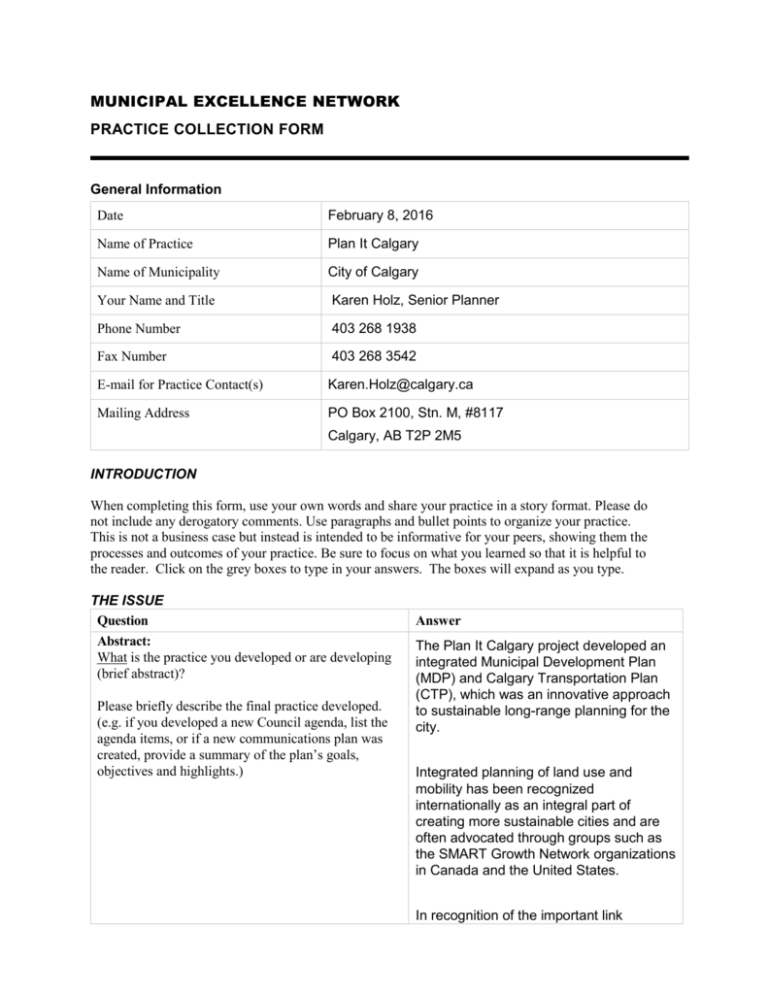
MUNICIPAL EXCELLENCE NETWORK PRACTICE COLLECTION FORM General Information Date February 8, 2016 Name of Practice Plan It Calgary Name of Municipality City of Calgary Your Name and Title Karen Holz, Senior Planner Phone Number 403 268 1938 Fax Number 403 268 3542 E-mail for Practice Contact(s) Karen.Holz@calgary.ca Mailing Address PO Box 2100, Stn. M, #8117 Calgary, AB T2P 2M5 INTRODUCTION When completing this form, use your own words and share your practice in a story format. Please do not include any derogatory comments. Use paragraphs and bullet points to organize your practice. This is not a business case but instead is intended to be informative for your peers, showing them the processes and outcomes of your practice. Be sure to focus on what you learned so that it is helpful to the reader. Click on the grey boxes to type in your answers. The boxes will expand as you type. THE ISSUE Question Abstract: What is the practice you developed or are developing (brief abstract)? Please briefly describe the final practice developed. (e.g. if you developed a new Council agenda, list the agenda items, or if a new communications plan was created, provide a summary of the plan’s goals, objectives and highlights.) Answer The Plan It Calgary project developed an integrated Municipal Development Plan (MDP) and Calgary Transportation Plan (CTP), which was an innovative approach to sustainable long-range planning for the city. Integrated planning of land use and mobility has been recognized internationally as an integral part of creating more sustainable cities and are often advocated through groups such as the SMART Growth Network organizations in Canada and the United States. In recognition of the important link between land use, mobility and sustainability, The City of Calgary Council approved the Terms of Reference for the Integrated Land Use and Mobility Plan in January 2007, which became known as the Plan It Calgary project. The project's mission was to achieve a more sustainable Calgary by integrating land use and mobility policy and creating effective implementation strategies, practical tools and processes for decision makers. The outcome of the Plan It Calgary project was the creation of a new Calgary Municipal Development Plan (MDP) and Calgary Transportation Plan (CTP). Key questions that were asked at the outset of the project were: How we can accommodate an additional 1.3 million people and 600,000 jobs over the next 50 - 60 years in the city? Where will they live, work, and play? What do we need to do differently to ensure a high quality of life? The goals of the Plan It Calgary project were to: * Develop a set of overarching sustainability principles. * Develop a framework that organizes the city into a limited number of geographic areas ("typologies"), based upon common characteristics of urban form and function. * Rigorously evaluate the proposed urban system to ensure it is the appropriate framework around which to organize future land use and mobility policies and objectives in the MDP/CTP. * Create a long-range land use and multimodal (road, transit, pedestrian and cycling) mobility scenario for Calgary and the region at 2.5 million people, building on the sustainability principles. * Create the scenario using a multistakeholder, collaborative, design charette approach. Develop and test multiple scenarios and identify the implications of various scenarios. * Develop an integrated land use and transportation policy and bring forward a new Municipal Development Plan and Calgary Transportation Plan. * Develop indicators (and long term targets) to monitor the progress of the plan(s). The Plan It Calgary project resulted in: 1. Eleven Sustainability Principles to guide land use and mobility. 2. Towards a Sustainable City: The Case for Change. This is a background document that describes why the city needs to change how it has been growing and address social, economic, and environmental rationale. 3. Towards a Sustainable City: The 8 key directions for land use and mobility. This document outlines key strategies for city growth. It is available at www.calgary.ca/planit 4. The Calgary Municipal Development Plan The Calgary Muncipal Development Plan (MDP) is a long-range plan (60 year focus with 30 year strategies) for how development and growth will occur in Calgary. The goals of the MDP focus on the following areas: * A prosperous economy - Build a globally competitive city that supports a vibrant, diverse and adaptable local economy, maintains a sustainable municipal financial system and does not compromise the quality of life for current and future Calgarians. * Shaping a more compact urban form Direct future growth of the city in a way that fosters a more compact, efficient use of land; creates complete communities; allows for greater mobility choices; and enhances vitality and character in local neighbourhoods. * Creating great communities - Create great communities by maintaining quality living and working environments, improving housing diversity and choice, enhancing community character and distinctiveness and providing vibrant public places. * Urban Design - Make Calgary a liveable, attractive, memorable and functional city by recognizing its unique setting and dynamic urban character and creating a legacy of quality public and private developments for future generations. * Connecting the city - Develop an integrated, multi-modal transportation system that supports land use; provides increased mobility choices for citizens; promotes vibrant, connected communities; protects the natural environment; and supports a prosperous and competitive economy. * Greening the city - Conserve, protect and restore the natural environment. * Create a framework for growth and change - As stewards of the land within its jurisdiction, The City of Calgary will provide leadership on growth and change within a strategic framework that achieves the best possible social, environmental, and economic outcomes while operating within The City's financial capacity. 5. The Calgary Transportation Plan The Calgary Transportation Plan (CTP) is a long-range plan for providing more choices for travelling throughout Calgary. The plan emphasizes comfortable, safe, walkable streets designed for all users. The CTP aims to make it easier to travel throughout the city by car, on foot, by bicycle or on the bus as Calgary's population grows. Immediate improvements are being made to enhance public transit, build better streets and make the best use of the existing transportation system in Calgary. The goals of the CTP are to: * Provide safety for all transportation system users. * Provide affordable mobility and universal access for all. * Enable public transit, walking and cycling as the preferred mobility choices for more people. * Provide economic development by ensuring the effective movement of workers and goods. * Advance environmental sustainability. The innovations demonstrated in this practice are described in Question 2 of the cover page and include: Use of 13 new indicators and thresholds in addition to the traditional measure of density; Introduction of land use typologies and related policies and planning solutions; Integration of land use and transportation, including transit-supportive land uses and new, multi-modal streets; A more regional transportation planning perspective; New processes and design concepts, such as connectivity assessments, quality of service and mobility assessment plans that assess transportation and land use from a multi-modal perspective. Need: Please describe (just a couple of sentences or bullet The previous Calgary Plan (MDP 1998) and Go Plan (CTP 1995) introduced the points) why you needed to create this practice (policy or process). What issue made it necessary? (e.g. “We needed a comprehensive plan to deal with…”, or “We needed an annual forecasting tool because…”) principles of sustainable development into the statutory planning framework and included policy direction to integrate social, environmental and economic objectives into a coordinated decisionmaking process. Since then, Calgary has experienced rapid, substantial growth, which has strained The City’s ability to provide and maintain infrastructure and services to citizens. It became apparent that The City needed a vision and plan for more sustainable growth and development. The Plan It Calgary project identified the need to more fully integrate the transportation (mobility) policy with land use policy and take a more integrated approach to implementation, monitoring and reporting. The new statutory MDP and companion CTP set out a long-term 60-year strategy for a more sustainable city form for Calgary and the transportation networks needed to serve it. This is supported by a 30-year plan for managing growth and change, public investment and land use approval decisions. Finally, short-term, 10year, corporate decision-making, business planning, implementation and accountabilities are aligned to the strategies and plan to support Calgary’s move to being a more sustainable city. Calgary’s ongoing shift towards sustainability and the need to make the best possible use of public resources to maintain economic, environmental and social well-being for all Calgarians was necessitated by the following emerging issues: * the need to reduce our impact on the environment; * projected lifestyle and demographic changes (aging population); * Public health and wellness trends; * The increasing cost of living as transportation and housing costs continue to rise; and * The cost of growth and fiscal constraints on The City of Calgary. CREATING YOUR PRACTICE Research: How did you obtain information to help design your practice (including consultation with stakeholders, formal and informal research)? Please include any research documentation you can share, or give us a source reference (e.g. Web site, literature, “We reviewed the bylaws from other municipalities in the area…”). Plan It Calgary conducted substantial inhouse studies, commissioned a number of research papers by leading international experts, and carried out an extensive internal and external engagement program. In addition, substantial review of best practices and emerging literature on a range of topics was completed as part of the policy development. Formal research that was conducted as a part of the Plan It Calgary project is available at www.calgary.ca/planit. It includes: A Context for Change Management: Demographic Changes The Built Environment and Health & Wellness Housing Affordability and Smart Growth in Calgary Commercial and Retail Strategies Green Infrastructure for Streets Energy Mapping in Calgary 17th Avenue SE Case Study Charrette Greenfield Community Case Study Charrette Extensive consultation with stakeholders was also conducted. Two public opionion surveys, nine focus groups, three charettes, as well as numerous workshops and meetings were conducted. In addition, an advisory committee with representation from the development industry, and social, economic and environmental interest groups was formed to enable detailed debate and discussion on the plans. Process: How did you go about designing your practice? For instance, did you create a team, hire a consultant, borrow something ready-made from another jurisdiction? Describe briefly who did the design work and what A dedicated project team was formed for the project. The General Managers of Transportation and Planning Development and Assessment, as well as the Directors of Land Use Planning and Transportation Planning were the project sponsors. The process they followed. original project team was led by a Program Manager and supported by a program administrator, four land use planners, five transportation planners and a transportation planning student. The Design Centre for Sustainability, which is associated with the University of British Columbia, was a key consultant in the development of the design process. Plan It Calgary studied the city at multiple scales. At the city-wide scale, three possible future scenarios were developed and evaluated based on their ability to achieve sustainability. The scenarios were measured against a series of indicators. One scenario showed what Calgary would be if it continued to build outwards, while another examined what would happen to Calgary if all new growth occurred in the existing parts of the city. The third scenario fell between the first two. Using the assessment of the three scenarios as a starting point, the public and key stakeholders were engaged to determine which future scenario they thought would be best for the city. This information was then used to develop eight key directions for land use and mobility. Additional consultation was conducted on the eight key directions prior to the development of a new draft land use concept. A major public event called ‘Plan It Calgary Summit’ was then held. The Summit included workshops, international public speakers, expert panels and questions answer sessions on specific policy topics in a conference-like setting. Over 400 members of the public attended. Following the Summit, the draft planning framework was developed. Additional public information and education sessions were held. This resulted in the development of the proposed MDP and CTP documents that were then presented at Council. Following the public hearing, Council directed the Administration to incorporate several changes in the documents before they were returned to Council for final adoption. GETTING APPROVAL FOR YOUR PRACTICE Authority: Whose/what approval did you need to create and implement the practice? Reporting: How did you inform the decision-maker(s) about the practice and your need for their approval? Please note the name of any documents provided to the decision-makers that you would be willing to share. City Council was the approving authority. The MDP was adopted by bylaw and the CTP was adopted by resolution. Stages of approval and direction from City Council included: * Approved Terms of Reference (January 2007) * 11 sustainability principles (January 2007) * Towards a Sustainable City: The case for change (April 2008) * Towards a Sustainable City: Eight key directions (October 2008) * Public hearing June 2009 with over 100 presenters * September final adoption (CTP adopted, MDP bylaw received 3rd reading with an effective date of April 1, 2010) Consultation: Did you consult with stakeholders as part of your approval process? If so, how? If possible, attach a copy of templates, surveys or other documents you used as part of your consultation. Over 6,000 citizens were engaged through a variety of means including telephone and internet surveys, focus groups, charrettes, workshops, open houses and public hearing.Extensive engagement and communications took place within City of Calgary Administration throughout the entire timeline of the project. Engagement Summary Reports are available at www.calgary.ca/planit IMPLEMENTING YOUR PRACTICE Plan: Describe the process you went through to implement the practice. If you used an implementation plan, please note it here. Implementation – Describe the process you went through to implement the practice. The Implementation Strategy was approved by Council in February 2010. An Implementation Committee was established to work through immediate challenges and ensure smooth transition from policy to action. As a result of this committee, a 'User Guide' for the MDP was created to provide answers to frequently asked questions regarding interpretation and implementation of the plan. In June 2010, the Implementation Committee was dissolved and a new ongoing Sustainment Committee was formed to deal with strategic and detailed policy and implementation challenges. The City of Calgary will be implementing the MDP and CTP over the next 10 years through: 1. decisions on land use planning and transportation investment through the review of development permits and local area plans, 2. immediate implementation priorities that include new plans, practices, processes and projects, 3. aligning the three-year business plan and budget processes and the 10year infrastructure capital programs, with the MDP and CTP, 4. continued communication, education and engagement with internal and external stakeholders, including staff, the development industry, business groups, community associations, other special interest groups and the public, 5. ongoing monitoring and reporting on the 60-year targets and indicators, interim targets and related three-year performance measures. Policy: What changes to bylaws, regulations or procedures were needed to implement this practice and how did you deal with them? Please attach a copy of the change in bylaw, policy or procedure. The previous MDP Bylaw was revoked and the new one approved. The Growth Management framework established in the MDP is currently being operationalized in the corporation (City of Calgary). The CTP was adopted by resolution. In addition, The User Guide to the Municipal Development Plan and the Calgary Transportation Plan describes changes to the following plans and procedures: • Changes to Local Area Plans • Application Approval Process • Land Use Amendments • Community Design and Outline Plans • When: When did your municipality begin to use the practice? Was it implemented all at once or in stages? Development Permit Applications The CTP was approved by Council September 28, 2009 and became effective immediately. The Municipal Development Plan was approved in September, 2009 and became effective April 1 2010. Who: Who was responsible for implementing the practice? If someone else is responsible for ongoing management, who is it? Implementation began as soon as each plan became effective. Although a corporate directive intended the plans to be implemented across the corporation, the Transportation and Planning, Development, and Assessment departments are largely responsible for the implementation of the plans. The Implementation and Sustainment Committee which include key stakeholders will continue to ensure that the plans remain current and that issues with respect to implementation are resolved. In addition, internally, the Directors Integrated Growth Committee (representing several departments) will continue to work to ensure that work programs are aligned and growth management issues are addressed and integrated across the corporation. RESOURCES REQUIRED Budget: How much did it cost you to design and implement your practice (i.e. We saved/spent $XX per year)? What are your ongoing operational and capital costs, if any? This long-range planning process has been taking place over the past four years. The $6 million investment has included extensive commissioned, independent research; lengthy and on-going consultation with key stakeholders from the business community and development/homebuilding industry and other special interest groups; and substantial community engagement. As a result of the new plans and more compact urban development it is estimated that The City will have an $11 Billion savings over the next 60 years. Ongoing implementation is using existing resources within the Transportation Department and Planning, Development and Assessment Department. Operational education and training on application of the new plans is underway ($100K one time). Staff: What human resources did you need to design, implement and manage your practice? (e.g. “It took X staff member(s) X months on this” or “This is part of normal staff duties.”) The original project team consisted of five transportation planners, four land use planners, an administrator and a student. The composition of the team varied over the course of the project and has now been dissolved. Staff are now working on implementing the plan through their respective business units. Infrastructure: What “capital costs” (such as information technology,other equipment or building assets) did you need to design, implement, manage, and/or evaluate your practice? The integrated MDP and CTP have not incurred direct capital costs; however, the plans will be implemented through operational business plans and budgets, including the 10-year capital infrastructure program, which will be developed and approved through the 2012-2014 business planning and budget coordination process. EVALUATING YOUR PRACTICE Formal: If you did a formal evaluation (e.g. user satisfaction survey, analysis of annual expenditures or number of rate payers served) for your practice, please describe the evaluation tool and the process used. Tell us who was involved. Through the internal and external engagement processes described and through the public hearing at Council, a wide variety of people had the opportunity to critically evaluate the MDP and CTP. Over 100 people presented at the public hearing. A large proportion of these came out to support the plan. Council unanimously supported the adoption of the MDP. Informal: If you did an informal evaluation, describe what you did (such as discussing the practice with people in the office or on the street, or letters/comments received). Positive feedback has been received from various stakeholders and they are supportive of the on going commitment for engagement through the Sustainment Committee and broad public dialogue. Performance measures: Please list the performance measures for this practice (i.e. reduced number of complaints, money saved, or change in equipment life expectancy.) The MDP has established 14 indicators that will be tracked and reported on every three years. These are: Please list the process you used for measuring performance, (i.e. We do annual surveys on…) examples include: collecting data establishing a baseline applying the measures results follow up 1. Urban expansion – per cent of population growth accommodated within the developed area 2. Density – people and jobs per hectare 3. Population / jobs balance – population/jobs east to west and north to south ratios 4. Mix Land Use – land use diversity index 5. Residential mix – residential diversity index 6. Road and Street infrastructure – roads to streets ratio 7. Accessibility to primary transit – per cent of population and jobs within 400 m of primary transit network 8. Transit Service – Annual transit service hours per capita 9. Goods Access – per cent of intermodal and warehousing facilities within 1600 m of Primary Goods Movement Network 10. Transportation Mode Split – Walking/Cycling/Transit/Auto 11. Accessibility to Daily Needs – per cent population within Major and Community Activity Centres and 600m of Urban and Neighbourhood Corridors 12. Watershed Health – per cent of impervious surface 13. Urban Forest – per cent of tree canopy 14. District Energy – Per cent of land area with densities supportive of district energy systems Changes: (a) Based on the evaluation (formal or informal), describe any changes you have made, or would like to make, to your practice as a result. (e.g. “After implementing this practice, we decided that it would be better if…”) -or(b) Has your practice met your expectations and if so, how? LESSONS LEARNED / BENEFITS RECEIVED Benefits: What are the benefits of this practice to your municipality? (eg. Preparation of Council agenda packages now requires less time, etc.) Through the implementation of the MDP and CTP, Plan It Calgary will guide the operation of more than $50 billion worth of existing infrastructure resources and will establish guidelines for how tax dollars will be invested over several decades. Established a framework for a long term sustainable city, with environmental, social, economic and corporate financial sustainability for future generations. Key Lessons: What key lessons have you/your municipality learned through the process of: designing; obtaining approval; implementing; and evaluating your practice? Include any problems, surprises, and unanticipated benefits. (e.g. “We realized that we needed to spend more time…”) Conducting the research was essential for identifying and understanding the costs of Calgary’s growth model: public health; fiscal health; costs to the environment; housing affordability Having a strong education component and public engagement and awareness was key. Having outside experts present issues and possible alternatives regarding Calgary’s current situation and outlook was instrumental in identifying the need for a more sustainable growth model. Establishing ongoing committees (i.e. Implementation and Sustainment Committees) are useful to allow plans to proceed, yet recognizing continued discussions to occur. These committees, however, should have a very clear mandate and terms of reference. Although public opinion surveys can be expensive, they enable a deeper understanding of the values and attitudes of citizens towards specific issues and provide a statistically sound basis for evaluating alternatives.They are also helpful in balancing the perspectives of special interest groups who may participate heavily in the public hearing process. Having quantitative targets to support qualitative statements provide direction, yet allow flexibility to be achieved. Don't under estimate the public's drive for change. Advice to Municipal Peers: What advice would you give to another municipality that is considering adopting your practice? Is there anything you might have done differently? Bring your Council, citizens, and stakeholders along slowly and through frequent report backs, public engagement sessions, etc. This builds buy-in along the way and allows frequent course corrections to help build consensus and support. The development of a comprehensive internal training and education program for staff (and for engaged members of the public) is key. Don’t underestimate how much time and effort this will take. The City has nearly completed several eLearning modules and continues to meet on a regular basis to ensure consistency of interpretation. Coordinating the roll out of numerous new initiatives that are linked needs to be well thought out. This ensures alignment of interdependent implementation strategies and coordination of communications and engagement with internal and external stakeholders. PRACTICE UPDATES New Information: There may be some new information to add since this practice was first posted. This is especially true if: a new process has been implemented in your municipality; there are new practice evaluation results; or there has been a change affecting organizational direction. For example, explain how new economic conditions or a new vision/strategy affect the practice. Please indicate those changes here. Don't forget to list any new documents that may be useful to your peers. Then go to "Other Information" to attach the new documents. OTHER INFORMATION Suggestions: Please list relevant information sources that others might use or you would be willing to share (courses, Web sites, literature, experts). Documents & Attachments: Please list any documents you would be willing to share with others interested in your practice (e.g. a bylaw, a policy, approval documents, templates). * Note: Most documents can be electronically attached to your practice in the MEnet database. If only a paper version of your document is available, please send it with your completed Practice Collection Form. We will scan it and attach it. All the Plan It Calgary documents, research, and public engagement reports are available for download at www.calgary.ca/planit and include: Engagement Findings • 2007, Telephone Survey and Workbook Questionnaire Results • February 2008, Focus Group Results (Weaver) • March 2008, 17 Avenue SE Charrette report • June 2008, Summary of Feedback on Key Directions from the Federation of Calgary Communities (FCC) Workshops • July 2008, On-line stakeholder and public feedback on The Consultation Paper- Towards a sustainable city: key directions for land use and mobility • February 2009, Citizen Public Opinion Survey on the Key Directions for Land Use and Mobility- Results (Ipsos Reid) Plan It Calgary Research • A Context for Change Management in the Calgary Regional Partnership Area • Research Backgrounder Housing Affordability and Smart Growth in Calgary Report • Housing Affordability and Smart Growth in Calgary Report • Greenfield Case Study Charrette • The Built Environment and Health and Wellness • Green Infrastructure in Calgary's Mobility Corridors • Recommended Direction for Citywide Commercial / Retail Policy • Local Transportation Connectivity • Energy Mapping Study • Plan It Calgary Cost Study Analysis April 3, 2009 Plan It Calgary Publications • Introduction, background and methodology of the MDP and CTP • Plan It Calgary Sustainability Principles • Where do we grow from here? workbook • Towards a sustainable city: The case for change • Towards a sustainable city: key directions for land use and mobility Consultation paper (complete) • Plan It Calgary Key Directions for Land Use and Mobility Paper Nominations: Do you have any suggestions of other individuals or municipalities with municipal practices that we should add to the Municipal Excellence network? Please list their practice, municipality, and contact information. Or, e-mail menet@gov.ab.ca and let us know about a municipal colleague that has a really good way of doing things. COMMENTS Have we missed something; anything you’d like to add to the areas we have touched on, or an area we have not mentioned? Thank you for your contribution to the Municipal Excellence network. Please return this form as soon as you are able.


